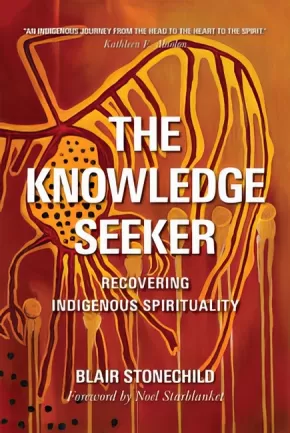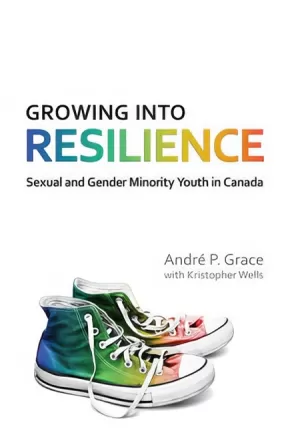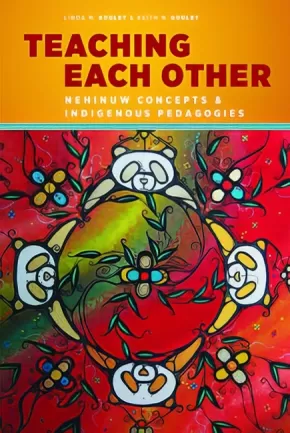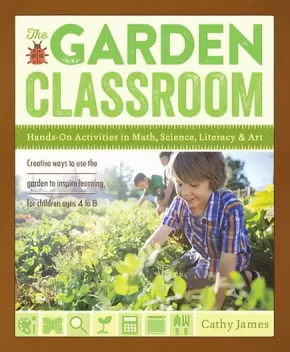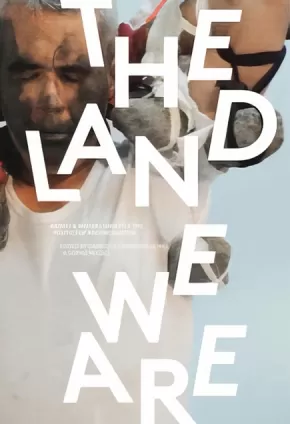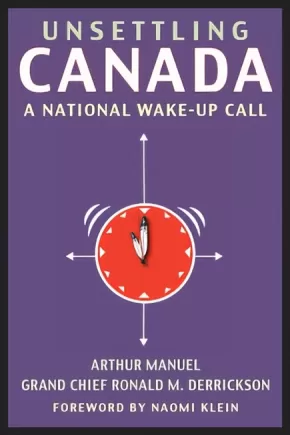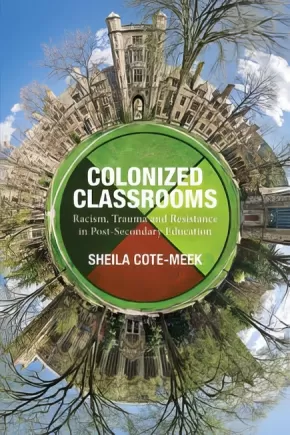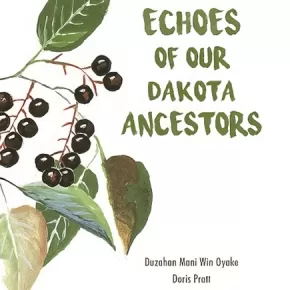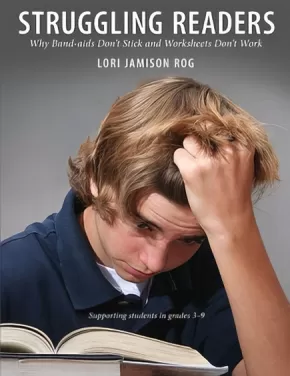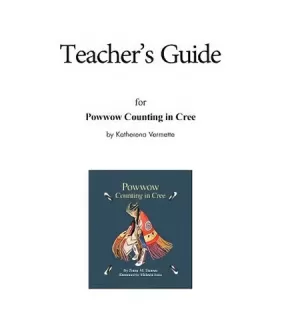
Educator Resources
166
-
180
of
213 Results;
Sort By
Go To
of 15
The Knowledge Seeker: Embracing Indigenous Spirituality
$32.95
Format:
Paperback
Text Content Territories:
Indigenous Canadian;
Grade Levels: University/College;
ISBN / Barcode: 9780889774179
Synopsis:
Synopsis:
The Knowledge Seeker tells the story of the developing Indigenous-run education movement and calls forth the urgent need to teach about Indigenous spirituality.
Educator Information
Table of Contents
Foreword
Acknowledgments
Introduction
CHAPTER 1: Wanting to Know
CHAPTER 2: Controlling Our Education
CHAPTER 3: The Great Principle
CHAPTER 4: The Great Law
CHAPTER 5: Once Powerful Healing
CHAPTER 6: Re-evaluating the Past
CHAPTER 7: Contemporary Crisis
CHAPTER 8: Modern Study of Spirit
CHAPTER 9: Restoring Balance
EPILOGUE: "Creator Does Not Lose His Children"
Notes
Glossary
Bibliography
Index
Additional Information
224 pages | 6.00" x 9.00"
Aboriginal Student Engagement and Achievement (1 in Stock) - ON SALE!
$24.75 $32.95
Format:
Paperback
Text Content Territories:
Indigenous Canadian;
Grade Levels: University/College;
ISBN / Barcode: 9780774826563
Synopsis:
Synopsis:
Aboriginal people want an education that reflects their cultural values and linguistic heritages, an education that will foster their children's engagement and identity and not marginalize them as learners. This book turns the spotlight on a rare success story – one Ontario high school's attempt to recognize Aboriginal students' cultural and academic needs while helping them build relationships with non-Aboriginal students. Aboriginal students constitute one of the fastest-growing groups in public schools. This timely study not only reveals how the current system is failing Indigenous students – it offers recommendations for enhancing their achievement levels in Canada and abroad.
Additional Information
212 pages | 6.00" x 9.00"
Growing into Resilience: Sexual and Gender Minority Youth in Canada
$38.95
Format:
Paperback
Grade Levels: University/College;
ISBN / Barcode: 9781442629042
Synopsis:
Synopsis:
Despite recent progress in civil rights for sexual and gender minorities (SGM), ensuring SGM youth experience fairness, justice, inclusion, safety, and security in their schools and communities remains an ongoing challenge. In Growing into Resilience, André P. Grace and Kristopher Wells – co-founders of Camp fYrefly, a summer leadership camp for SGM youth – investigate how teachers, healthcare workers, and other professionals can help SGM youth build the human and material assets that will empower them to be happy, healthy, and resilient.
Grace and Wells investigate the comprehensive (physical, mental, and sexual) health of SGM youth, emphasizing the role of caring professionals in an approach that that recognizes and accommodates SGM youth. Throughout, the authors draw upon the personal narratives of SGM youth, emphasizing how research, policy, and practice must act together for them to be able to thrive and fulfill their promise.
Both a resource for those professionally engaged in work with sexual and gender minorities and a comprehensive text for use in courses on working with vulnerable youth populations, Growing into Resilience is a timely and transdisciplinary book.
Teaching Each Other
$32.95
Format:
Paperback
Text Content Territories:
Indigenous Canadian; First Nations; Cree (Nehiyawak);
ISBN / Barcode: 9780774827584
Synopsis:
Synopsis:
In recent decades, educators have been seeking ways to improve outcomes for Indigenous students. Yet most Indigenous education still takes place within a theoretical framework based in Eurocentric thought. Teaching Each Other provides an alternative framework for teachers working with Indigenous students – one that moves beyond merely acknowledging Indigenous culture to one that actually strengthens Indigenous identity. Drawing on Nehinuw (Cree) concepts such as kiskinaumatowin, or "teaching each other," Goulet and Goulet demonstrate how teachers and students can become partners in education. They provide a template for educators anywhere who want to engage with students whose culture is different from that of the mainstream.
Additional Information
256 pages | 6.00" x 9.00"
The Garden Classroom: Hands-On Activities in Math, Science, Literacy, and Art
$28.95
Format:
Paperback
ISBN / Barcode: 9781611801644
Synopsis:
Synopsis:
Creative ways to use the garden to inspire learning, for kids ages 4-8
Packed with garden-based activities that promote science, math, reading, writing, imaginative play, and arts and crafts, The Garden Classroom offers a whole year of outdoor play and learning ideas—however big or small your garden.
Every garden offers children a rich, sensory playground, full of interesting things to discover and learn about. There's a whole lot of science happening right before their eyes. The garden can also be a place to develop math and literacy skills, as the outdoors offers up plenty of invitations to weave learning into everyday gardening. The garden classroom is a place where plants grow, and where children grow too.
Additional Information
232 pages | 7.02" x 8.50" | Paperback
The Land We Are: Artists and Writers Unsettle the Politics of Reconciliation
$24.95
Editors:
Format:
Paperback
Text Content Territories:
Indigenous Canadian;
ISBN / Barcode: 9781894037631
Synopsis:
Synopsis:
The Land We Are is a stunning collection of writing and art that interrogates the current era of reconciliation in Canada. Using visual, poetic, and theoretical language, the contributors approach reconciliation as a problematic narrative about Indigenous-settler relations, but also as a site where conversations about a just future must occur. The result of a four-year collaboration between artists and scholars engaged in resurgence and decolonization, The Land We Are is a moving dialogue that blurs the boundaries between activism, research, and the arts.
The contributors to this book include leading artists and scholars engaged in questions of resurgence, restitution, and decolonization.
Contributors: Jordan Abel, Leah Decter, Jonathan Dewar, David Garneau, Ayumi Goto, Allison Hargreaves, Gabrielle L'Hirondelle Hill, Jaimie Isaac, David Jefferess, Layli Long Soldier, The New BC Indian Art and Welfare Society Collective, Sophie McCall, Peter Morin, Skeena Reece, Dylan Robinson, Sandra Semchuk, Adrian Stimson, Clement Yeh, and Keren Zaiontz.
Reviews
"This beautifully produced, richly illustrated volume not only offers readers a visual journey into the featured artistic installations and performance pieces, but through its creative use of text and graphic design is itself an artistic statement on reconciliation." --Winnipeg Free Press
Educator Information
Recommended for students in grades 11 and 12, as well as at a college/university level.
Additional Information
240 pages | 6.50" x 9.50"
Unsettling Canada: A National Wake-Up Call
$29.95
Format:
Paperback
Text Content Territories:
Indigenous Canadian;
ISBN / Barcode: 9781771131766
Synopsis:
Synopsis:
Unsettling Canada, a Canadian bestseller, is built on a unique collaboration between two First Nations leaders, Arthur Manuel and Grand Chief Ron Derrickson.
Both men have served as chiefs of their bands in the B.C. interior and both have gone on to establish important national and international reputations. But the differences between them are in many ways even more interesting. Arthur Manuel is one of the most forceful advocates for Aboriginal title and rights in Canada and comes from the activist wing of the movement. Grand Chief Ron Derrickson is one of the most successful Indigenous businessmen in the country.
Together the Secwepemc activist intellectual and the Syilx (Okanagan) businessman bring a fresh perspective and new ideas to Canada’s most glaring piece of unfinished business: the place of Indigenous peoples within the country’s political and economic space. The story is told through Arthur’s voice but he traces both of their individual struggles against the colonialist and often racist structures that have been erected to keep Indigenous peoples in their place in Canada.
In the final chapters and in the Grand Chief’s afterword, they not only set out a plan for a new sustainable indigenous economy, but lay out a roadmap for getting there.
Reviews
“This is the back story of both grassroots and backroom struggles that created the context in which we find ourselves today, one in which a new generation of First Nations leaders is demanding sovereignty and self-determination, and more and more non-Indigenous Canadians finally understand that huge swaths of this country we call Canada is not ours - or our government's - to sell.” — Naomi Klein, from the Foreword
“Pragmatic and helpful, this is a timely book for our fraught and political moment” — Quill & Quire
"Unsettling Canada is a breathtakingly beautiful story of Indigenous resistance, strength, and movement building. Unsettling Canada echoes the power of George Manuel's The Fourth World, centering the heart of the narrative deep inside a kind of Indigenous intelligence rarely shared outside our communities. This is the critical conversation that Canada and Indigenous peoples must have because it is centred on land, and, therefore, it is one of the most important books on Indigenous politics I've ever read." — Leanne Betasamosake Simpson, author of Dancing on Our Turtle's Back
Educator Information
This resource would be useful for courses in history, social justice, political science, and social studies. Recommended for students in grades 10 to 12 or those at a college/university level.
CONTENTS
Foreword Naomi Klein
Chapter 1 The Lay of the Land
Chapter 2 Institutionalizing a People: Indian Hospital, School, Jail
Chapter 3 White Paper to Red Paper: Drawing the Battle Lines
Chapter 4 Occupy Indian Affairs: Native Youth in Action
Chapter 5 Aboriginal Title: No Surrender
Chapter 6 The Constitution Express: A Grassroots Movement
Chapter 7 Don’t Let Them Bully You: A Business Interlude
Chapter 8 A Chief’s Concerns: Finances, the People, and the Land
Chapter 9 Upping the Ante: RCAP and a Landmark Court Decision
Chapter 10 The Battle in the Forest: The Trade in Indian Trees
Chapter 11 Sun Peaks to Geneva: Playgrounds and Fortresses
Chapter 12 Taking It to the Bank: Accounting for Unpaid Debt
Chapter 13 The Fourth World: A Global Movement
Chapter 14 Line of Defence: Side by Side for Mother Earth
Chapter 15 No Half Measures: The Price of Uncertainty
Chapter 16 Days of Protest: Young Activists Come Together
Chapter 17 The End of Colonialism
Afterword Grand Chief Ronald M. Derrickson
Acknowledgements
Appendix United Nations Declaration on the Rights of Indigenous Peoples
Notes
Index
Additional Information
288 pages | 6.00" x 9.00"
Unsettling Canada: A National Wake-Up Call - Second Edition
$29.95
Format:
Paperback
Text Content Territories:
Indigenous Canadian;
ISBN / Barcode: 9781771135566
Synopsis:
Synopsis:
A Canadian bestseller and winner of the 2016 Canadian Historical Association Aboriginal History Book Prize, Unsettling Canada is a landmark text built on a unique collaboration between two First Nations leaders.
Arthur Manuel (1951-2017) was one of the most forceful advocates for Indigenous title and rights in Canada; Grand Chief Ron Derrickson, one of the most successful Indigenous businessmen in the country. Together, they bring a fresh perspective and bold new ideas to Canada's most glaring piece of unfinished business: the place of Indigenous peoples within the country's political and economic space.
This vital second edition features a foreword by award-winning activist Naomi Klein and an all-new chapter co-authored by law professor Nicole Schabus and Manuel's son, Ska7cis, honouring the multi-generational legacy of the Manuel family's work.
Reviews
“Pragmatic and helpful, this is a timely book for our fraught and political moment” — Quill & Quire
"Unsettling Canada is a breathtakingly beautiful story of Indigenous resistance, strength, and movement building. Unsettling Canada echoes the power of George Manuel's The Fourth World, centering the heart of the narrative deep inside a kind of Indigenous intelligence rarely shared outside our communities. This is the critical conversation that Canada and Indigenous peoples must have because it is centred on land, and, therefore, it is one of the most important books on Indigenous politics I've ever read." — Leanne Betasamosake Simpson, author of Dancing on Our Turtle's Back
Educator Information
This resource would be useful for courses in history, social justice, political science, and social studies. Recommended for students in grades 10 to 12 or those at a college/university level.
Additional Information
320 pages | 6.00" x 9.00"
Worth Writing About: Exploring Memoir with Adolescents
$27.95
Format:
Paperback
ISBN / Barcode: 9781625310484
Synopsis:
Synopsis:
"Who am I?" This is the question that many adolescents ask during the turbulent middle and high school years. In Worth Writing About: Exploring Memoir with Adolescents, Jake Wizner addresses how searching for the answer to this question leads his students to reflection, to reading, and ultimately to deeper, more meaningful writing.
Based on his experience teaching eighth-grade English for nearly two decades, Jake believes that a well-designed memoir unit not only aligns with the Common Core State Standards but also forges community in the classroom, encourages kids to read nonfiction, and works wonders with students who struggle with their writing -- or with their lives.
Worth Writing About addresses the most common challenges teachers face when teaching memoir writing: How do you help students who say that nothing interesting has happened in their lives? How do you help students balance what is meaningful with what is too personal to share? How do you help students overcome the "I don't remember" syndrome?
Jake -- who has published a young-adult novel and often shares his own writing with his students -- also delves into the craft of writing, from using mentor texts to crafting leads and memorable endings. He uses student models from his own classroom to show the deep, important work his students produce during the memoir unit.
The memoir unit gets kids to write about real stuff -- the things that matter to them. In the process, Jake believes, they learn more about themselves, their relationships, the way they view the world, and how they want to move forward into the future.
Colonized Classrooms
$27.00
Format:
Paperback
Text Content Territories:
Indigenous Canadian;
Grade Levels: University/College;
ISBN / Barcode: 9781552666531
Synopsis:
Synopsis:
COLONIZED CLASSROOMS
Racism, Trauma and Resistance in Post-Secondary Education
In Colonized Classrooms, Sheila Cote-Meek discusses how Aboriginal students confront narratives of colonial violence in the post secondary classroom, while they are, at the same time, living and experiencing colonial violence on a daily basis. Basing her analysis on interviews with Aboriginal students, teachers and Elders, Cote-Meek deftly illustrates how colonization and its violence are not a distant experience, but one that is being negotiated every day in universities and colleges across Canada.
Educator Information
Contents: Setting the Context • Conceptualizing the Impact of the Colonial Encounter • Negotiating the Culture/Colonial Divide in the Postsecondary Classroom • Negotiating Race in the Postsecondary Classroom • Trauma in the Classroom • Resisting Ongoing Racism and Colonialism in the Postsecondary Classroom • Closing the Circle: The Possibilities for Transformational Pedagogy • References
Additional Information
198 pages | 6.00" x 9.00" | Paperback
Cree Dictionary and Pocket Phrase Book Set, N Dialect
$19.95
Format:
Paperback
Synopsis:
“A good method of learning the Cree language, with its unique sounds, involves verbal communication between teacher and students.”
This Cree Dictionary and Everyday Phrases & Words book set was written by the last remaining fluent Cree Elders of Ochekiwi Sipi Cree Nation (Fisher River). Some of the Elders have passed on and this set is dedicated to their memory. The dialect is Maskekomowina – Swampy Cree, or N Dialect.
In both books, the English words are translated into Cree using Roman orthography, phonetics, and Cree syllabics. The Dictionary is a 149-page, coil bound publication. The Everyday Phrases & Words is a pocket-sized, 39-page booklet.
Echoes of Our Dakota Ancestors
$9.95
Format:
Paperback
Text Content Territories:
Indigenous Canadian; First Nations; Sioux; Dakota;
Grade Levels: University/College;
ISBN / Barcode: 9781927849156
Synopsis:
Synopsis:
Enjoy imakhmakhap woyakapi (enjoyments that are told) in Dakota. Each chapter in this charmingly illustrated booklet focuses on a month of the year, with stories, poems and songs in the Dakota language. Doris Pratt, a long time language teacher and material developer, shares this Dakota collection to help students learn and practice the language.
Educator Information
This book is written in the Dakota language. It is useful as a total Dakota language program or can be used to supplement any Dakota language course. It is suitable for adult language courses. Included in the appendices are explanations of the Dakota language and a prayer by Hector Bunn.
Struggling Readers: Why Band-Aids Don't Stick and Worksheets Don't Work
$24.95
Format:
Paperback
ISBN / Barcode: 9781551382920
Synopsis:
Synopsis:
It is a troubling statistic that a quarter of the students in any grade are reading below grade level. The good news is that it's not too late, even in middle school, to provide the extra instruction that will get the majority of these students back on track.
The practical, classroom-tested reading instruction strategies in Struggling Readers are carefully chosen to be effective with students in Grades 3–9. More than band-aid solutions that focus on discrete skills that don’t transfer to real reading, this insightful book shows teachers how to give struggling readers what they really need: the opportunity to read texts they can and want to read; explicit instruction in long-term strategies they can use on their own; confidence in themselves as readers, writers, and thinkers.
This comprehensive resource is organized around the instructional needs of struggling readers:
- teaching and texts targeted to their needs
- the opportunity to read more
- explicit instruction and guided practice in comprehension strategies • building vocabulary and fluency
- the ability to read informational and functional texts
- using writing to make sense of reading
The lesson routines are specifically designed for small-group work, but are adaptable to whole-class or individualized learning.
Struggling Readers is a valuable resource that will help teachers use guided reading strategies from the early grades to reach those students still struggling with reading basics.
Tales From Big Spirit Series Teacher's Guide
$29.00
Format:
Coil Bound
Text Content Territories:
Indigenous Canadian;
Grade Levels: University/College;
ISBN / Barcode: 9781553795261
Synopsis:
Synopsis:
This teacher’s guide is designed to help classroom teachers use the graphic novel series, Tales From Big Spirit, by David A. Robertson. The guide provides detailed lessons that meet a wide range of language arts and social studies goals, integrate Indigenous perspectives, and make curricular content more accessible to diverse learners. It is organized into three sections.
The first section includes:
- general instructional ideas for deepening readers’ comprehension of text.
- a framework to further develop students’ thinking about history.
- information about aspects of graphic novels and how to use them in the classroom.
The second section includes:
- specific instructional ideas and suggestions.
- an overview.
- detailed teaching and learning sequences (before-, during-, and after-reading format).
The appendix includes:
- strategies and reproducible classroom materials that support and stimulate student learning.
- historical images that may be reproduced.
Additional Information
74 pages | 8.50" x 11.00"
Teacher's Guide: Powwow Counting in Cree
$10.99
Format:
Paperback
Text Content Territories:
Indigenous Canadian; First Nations; Cree (Nehiyawak);
ISBN / Barcode: 9781553795087
Synopsis:
Synopsis:
Teacher’s Guide for Powwow Counting in Cree gives you engaging activities that take a deeper look at each illustration in the book, Powwow Counting in Cree. In this resource you will find:
- background information that addresses specific topics related to Cree culture and language
- detailed, easy-to-follow lesson plans for social studies, language arts, mathematics, and other content areas
- additional sources of information about Cree language and culture
- and much more.
Additional Information
28 pages | 8.00" x 9.00"
Sort By
Go To
of 15

